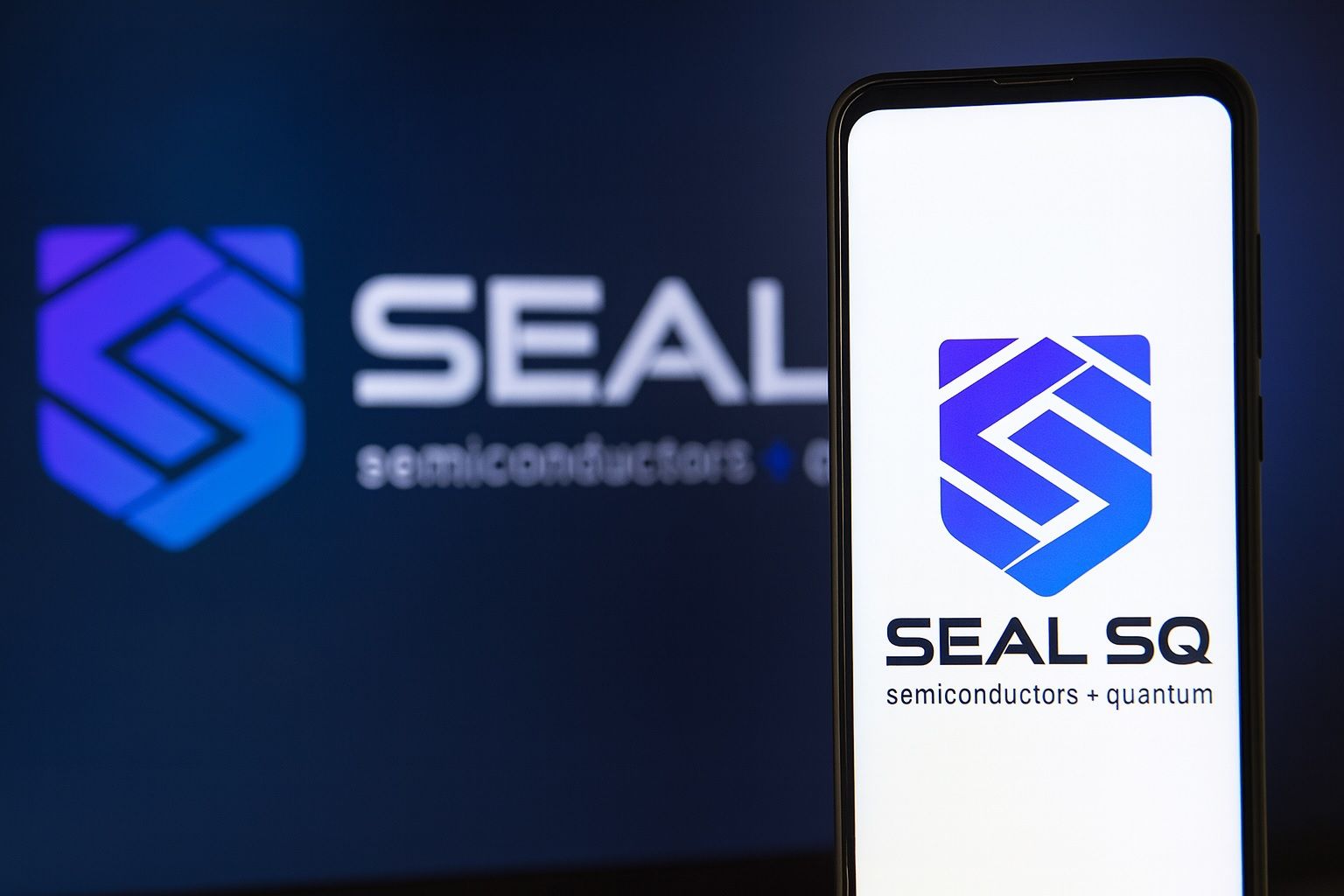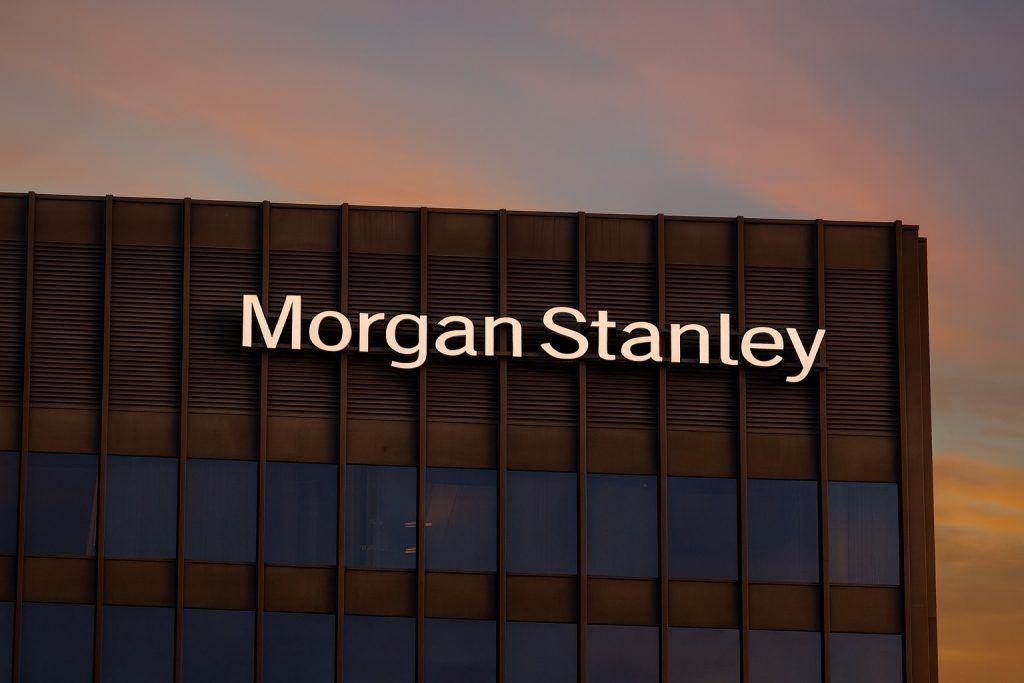- Soaring Stock:SEALSQ Corp (NASDAQ: LAES) has surged dramatically in October, quintupling from summer lows. Shares spiked 39.7% on Oct. 9 and another ~25% on Oct. 14, closing at $7.65 (nearly a $1 billion market cap) [1]. Heavy trading volumes (117 million shares on Oct. 9) underscore frenzied investor interest [2].
- Flurry of Deals: In the past week, SEALSQ announced major post-quantum security partnerships across finance, energy, and defense. On Oct. 14, it teamed with Switzerland’s Wecan Group to build a quantum-resistant KYC platform for banks [3]. A day earlier, it expanded a Landis+Gyr smart-grid security pact for North America [4]. On Oct. 9, it formed a U.S. joint venture with Trusted Semiconductor Solutions to co-develop “Made-in-USA” quantum-secure chips for defense agencies [5].
- Strong Growth & Cash: Preliminary results show 9M 2025 revenue $9.9 million (up +41% YoY) [6]. Q3 alone ($5.1M) exceeded the first half’s sales, and management reaffirmed robust FY 2025 revenue guidance of $17.5–20M (≈60–80% annual growth) [7]. To fund expansion, SEALSQ raised $69 million this month via warrant exercises, boosting its cash reserves to ~$220 million [8].
- New Chips & Satellite Launch: SEALSQ is slated to launch its Quantum Shield “QS7001” chip in November 2025, one of the first semiconductors with NIST-standardized post-quantum encryption embedded [9]. A next-gen “QVault” security module (quantum-resistant TPM) is due in 2026 [10]. Even the cosmos is in play – on Nov. 10, 2025, parent company WISeKey will launch a SpaceX Falcon 9 rocket carrying a nanosatellite equipped with SEALSQ’s post-quantum cryptographic tech to test secure, quantum-proof communications from orbit [11].
- Sector Tailwinds: SEALSQ’s rally comes amid booming semiconductor and AI markets. The Philadelphia Semiconductor Index jumped ~15% since September on AI chip demand optimism [12]. Meanwhile, governments are mandating quantum-safe security – the U.S. NSA requires all new federal systems to be quantum-resistant by 2027 [13]. Analysts project the global quantum security market will explode from ~$4 billion in 2024 to $72 billion by 2035 [14], creating massive long-term opportunity for post-quantum chipmakers like SEALSQ.
- Analyst Caution: Despite the euphoria, Wall Street remains cautious. Most analysts rate LAES “Hold/Neutral” with price targets around $6–6.50 – near current levels [15]. TipRanks’ AI-driven model flags valuation and execution risks even as momentum is strong [16]. Market veterans note SEALSQ is still unprofitable and highly volatile. The stock’s wild swings (from <$1 last year to >$11 at one point in 2025 [17]) reflect both its enormous promise and substantial risk, making prudent investors wary [18].
Post-Quantum Deals Ignite a Stock Rally
SEALSQ Corp – a Swiss-based provider of post-quantum cryptography semiconductors – has seen its stock rocket in the first half of October 2025 on the back of breakthrough announcements. Shares of LAES have climbed from the mid-$4 range in late September to roughly $7–8 by mid-October, buoyed by a string of strategic deals in quantum-secure technology [19]. The rally has been extreme even by small-cap tech standards: on October 9, SEALSQ’s stock price jumped nearly 40% in a single session after news of a U.S. defense-oriented partnership [20]. And on October 14, the momentum continued – LAES leapt another ~25% to close at $7.65 [21], a new multi-month high. This pushed the company’s market capitalization to around $1 billion, a stunning rise for a firm that traded under $1 per share as recently as last year [22].
Trading activity underscores the frenzy. On peak rally days, volume exploded into the hundreds of millions of shares – for instance, 117 million shares changed hands on Oct. 9, compared to an average of ~16 million [23]. “Market enthusiasm is at fever pitch,” noted one TS² TechStock analyst, as online forums filled with “moonshot” hype about SEALSQ’s prospects [24]. Such speculative fervor has yielded outsized gains but also wild volatility; earlier this year LAES spiked as high as $11 and later plunged below $0.50 [25]. This history of boom-bust swings highlights the stock’s speculative nature – current buyers are clearly banking on SEALSQ’s future, not its present financials.
Major Partnerships in Finance, Energy, and Defense
Driving the optimism are a flurry of partnership announcements positioning SEALSQ’s technology at the forefront of securing next-generation networks:
- Financial Sector (Oct. 14): SEALSQ unveiled a strategic collaboration with Wecan Group, a Swiss regtech firm, to develop a post-quantum Know-Your-Customer (KYC) solution for banks [26] [27]. The initiative will embed SEALSQ’s quantum-resistant cryptographic chips into Wecan’s compliance platform, aiming to protect sensitive client data from future quantum decryption threats [28]. “This partnership represents a major step forward in preparing regulated institutions for the post-quantum era,” said Carlos Moreira, CEO of SEALSQ, noting that the goal is to keep client data secure “even against future quantum attacks” [29]. Wecan Group’s CEO Vincent Pignon added that integrating post-quantum encryption “ensures our clients’ long-term data protection,” underscoring the financial industry’s focus on quantum-proof security [30].
- Smart Grid/IoT (Oct. 13): SEALSQ expanded its partnership with Landis+Gyr, a global smart-meter leader, to strengthen grid network security in North America [31]. Landis+Gyr will implement SEALSQ’s PKI (Public Key Infrastructure) solution at its U.S. meter factories, embedding unique digital certificates into millions of new electricity and gas meters during production [32]. This move builds on earlier projects (e.g. securing 30 million meters for TEPCO in Japan) and extends SEALSQ’s role in safeguarding critical energy infrastructure. “Landis+Gyr has a long history of prioritizing cyber security for the grid. By expanding our relationship with SEALSQ…we are positioned to continue evolving our security strategy to meet our utility customers’ needs well into the future,” said Todd Wiedman, Landis+Gyr’s Chief Security Officer [33]. SEALSQ’s IoT Security Director Gweltas Radenac noted the company is also “pioneering…quantum-resistant chips” to ensure utilities remain protected in the coming quantum era [34].
- U.S. Defense (Oct. 9): In a bid to enter the American defense market, SEALSQ announced a partnership with Trusted Semiconductor Solutions (TSS), a Minnesota-based, DoD-accredited contractor. Together they will co-develop “Made in USA” secure semiconductors featuring SEALSQ’s post-quantum cryptography, targeting the stringent needs of U.S. defense and government agencies [35] [36]. The roadmap includes a near-term integration of SEALSQ’s QS7001 secure element with TSS’s trusted chip platforms, and mid-term development of U.S.-made quantum-resistant chips meeting FIPS and Common Criteria certifications [37]. Carlos Moreira of SEALSQ called the alliance “a pivotal step” in the U.S. strategy, combining SEALSQ’s post-quantum leadership with TSS’s defense relationships to build “sovereign, quantum-resistant” infrastructure [38]. Allan T. Hurst, CEO of TSS, lauded SEALSQ as “truly unique” in its technology and vision, saying the partnership will deliver “unmatched trust and resilience” to secure critical U.S. systems in the quantum era [39].
- AI and Blockchain (Early October): SEALSQ’s push extends beyond these deals. Earlier this month, the company united with sister firm SEALCOIN AG (another WISeKey subsidiary) on a “Quantum-Resilient AI Agents” initiative [40] [41]. By embedding SEALSQ’s upcoming QS7001 chips into SEALCOIN’s decentralized AI agent platform, the project aims to future-proof autonomous AI systems against quantum attacks. “AI is only as trustworthy as the systems that protect it,” WISeKey CEO Carlos Moreira said of the effort, describing it as the “missing link” between artificial intelligence and post-quantum cybersecurity [42]. This underscores how SEALSQ’s tech is being applied to safeguard cutting-edge applications – from smart grids and defense networks to banking data and AI-driven platforms.
Each of these partnerships not only validates SEALSQ’s security solutions but also plugs the company into established industry players. The deals bring SEALSQ’s post-quantum hardware into real-world use-cases – from power meters and satellites to banking compliance – lending credibility to its technology. Investors have interpreted the flurry of agreements as a signal that SEALSQ’s innovation is gaining traction and commercial demand, helping to justify the stock’s sharp rise in recent days [43].
Financial Momentum and $69 Million Cash Boost
While much of the excitement is about the future, SEALSQ’s recent financial update showed tangible growth. On October 8, the company announced preliminary results for the first nine months of 2025, reporting $9.9 million in revenue, up 41% year-over-year [44]. Notably, Q3 2025 revenue was $5.1M, surpassing the combined total of Q1 and Q2 – evidence that business is accelerating into the second half [45]. SEALSQ attributed the growth partly to recovering demand for its legacy secure chips and initial contributions from a recent acquisition (France-based chip design firm IC’Alps, acquired in August) [46] [47]. Even so, the company acknowledged it is still in transition from older products to its next-gen post-quantum chips and software, which has tempered revenue in the short term [48].
Crucially, SEALSQ reaffirmed its full-year 2025 revenue forecast of $17.5–20.0 million, which would represent approximately +59% to +82% growth over 2024 [49]. Executives are optimistic that Q4 will be the strongest quarter yet – projecting $7.6M to $10.1M in Q4 sales – as new projects ramp up and recent partnerships begin contributing [50]. Looking further ahead, SEALSQ signaled an expected 50–100% growth in 2026 revenue, fueled by new product launches, the integration of IC’Alps, and revenue from a large Spanish quantum-security initiative (“Quantix Edge”) that SEALSQ joined this year [51] [52]. The company claims a growing business pipeline of $175 million in potential deals through 2028, reflecting rising global interest in quantum-safe technologies [53].
To support this rapid expansion, SEALSQ fortified its balance sheet with a substantial cash injection. On Oct. 6, it struck a deal with institutional investors (led by Heights Capital) to exercise 15 million outstanding warrants at $4.60, yielding $69.0 million in gross proceeds [54] [55]. In exchange for the immediate exercise, the investors received new long-dated warrants (at a $5.10 strike) as an incentive [56]. The financing, essentially a follow-on capital raise, boosted SEALSQ’s cash reserves to about $220 million as of Oct. 7 [57]. This “robust PQC innovation funding” (as one company statement called it) gives SEALSQ a considerable war chest to invest in R&D, product launches, and potentially further acquisitions [58]. With the post-quantum security race heating up, management emphasized that a strong cash position will help “solidify [the company’s] leadership” and meet growing demand for quantum-safe chips globally [59].
Notably, SEALSQ’s parent company WISeKey also remains financially involved – earlier this year, WISeKey injected $10 million into WISeSat.Space, its satellite unit, to accelerate the development of a “quantum-ready” constellation that will rely on SEALSQ’s secure chip technology [60]. The backing of WISeKey (itself a publicly traded cybersecurity firm) and fresh investor capital suggest that SEALSQ has the liquidity to pursue its ambitious roadmap – though it also means the share count has expanded significantly, which can dilute existing shareholders’ stakes [61].
Pioneering Products: From Quantum Chips to Secure Satellites
SEALSQ’s appeal to investors lies largely in its cutting-edge product pipeline, which promises to tackle the looming threat of quantum computing to digital security. The company is on the cusp of several major launches:
- Quantum Shield QS7001 (Nov 2025): Next month, SEALSQ will debut its flagship “QS7001” secure microcontroller, billed as one of the first chips with built-in post-quantum encryption algorithms [62]. This chip implements the latest NIST-approved quantum-resistant cryptographic standards at the hardware level, aiming to future-proof devices against quantum attacks. Management has highlighted QS7001 as a game-changer for industries like finance, government and IoT that require long-term data security [63]. Early engineering samples have already been delivered to pilot customers in 2025, and SEALSQ expects to start shipping production units and dev kits by late Q3 2025, with commercial revenues from QS7001 kicking in by 2026 [64].
- QVault TPM (2026): Following QS7001, SEALSQ is readying a “QVault” Trusted Platform Module, essentially a quantum-resistant security chip for servers, PCs, and connected devices. Pilot versions of QVault are slated for sampling in late 2025 and early 2026, with an eye toward full rollout in 2026 [65]. The QVault modules will target applications like blockchain networks, IoT devices, and defense systems, providing hardware-based authentication and encryption that can withstand quantum-level threats [66]. These products leverage SEALSQ’s expertise in secure elements (the company’s existing VaultIC chips already secure billions of IoT devices worldwide [67]) and extend it into the post-quantum era.
- Quantum-Secure Satellites: In a demonstration of its technological reach, SEALSQ is literally launching its security solutions into space. On November 10, 2025, WISeKey’s satellite arm (WISeSat.Space) will send a nanosatellite into orbit aboard a SpaceX Falcon 9 – a mission explicitly outfitted with SEALSQ’s post-quantum cryptographic semiconductors [68]. This satellite will test quantum-resistant communication protocols between space-based nodes and ground IoT networks [69]. Essentially, it’s a proof-of-concept that data relayed from orbit can be protected against even quantum-enabled eavesdroppers. “This will be one of the first demonstrations of post-quantum encryption tested in orbit,” WISeKey noted, calling it a pivotal step toward quantum-secure global connectivity [70]. If successful, it paves the way for four additional post-quantum satellites in 2026 and an eventual 100-satellite constellation aimed at providing secure, low-latency IoT communications worldwide [71]. The space initiative not only showcases SEALSQ’s innovation (earning headlines as a “blockchain satellite” launch [72]), but could unlock new markets in aerospace and defense that require ultra-secure links.
Together, these developments underline SEALSQ’s ambition to be a leader in post-quantum hardware. From chips in smart meters and smartphones to encryption modules in servers and even satellites, the company is casting a wide net. Its core strategy – integrating public-key infrastructure (PKI) and quantum-resistant cryptography into silicon – addresses a critical vulnerability: once quantum computers mature, many existing encryption methods (RSA, ECC) could be cracked, potentially exposing everything from banking transactions to military communications. By getting a technological head start, SEALSQ hopes to capture the wave of demand as industries upgrade their security for the “Q-day” when quantum attacks become a reality. As CEO Carlos Moreira put it, SEALSQ is “building a secure, connected, and quantum-resilient future” [73] – a vision that clearly resonates with forward-looking investors.
Industry Outlook: AI, IoT Drive Urgency for Quantum Security
SEALSQ’s surge comes at a time when multiple tech trends are converging to spotlight the importance of cybersecurity at the hardware level. One major factor is the AI boom. The voracious demand for AI chips and cloud datacenters in 2025 has lifted the entire semiconductor sector – companies like TSMC and NVIDIA are seeing multi-billion-dollar orders for cutting-edge chips, spurring a rally in chip equipment makers and suppliers [74] [75]. This positive tide has likely helped sentiment around niche chip stocks like SEALSQ. But more directly, AI systems themselves need protection: as AI is deployed in critical workflows (finance, healthcare, autonomous machines), ensuring those systems can’t be subverted by hackers (or future quantum code-breakers) is essential. SEALSQ’s partnership with Wecan and its involvement with SEALCOIN’s AI agent platform both underscore how post-quantum encryption is being woven into AI infrastructure to safeguard it [76].
Another driver is the Internet of Things (IoT) expansion. Billions of devices – from smart home gadgets to industrial sensors and smart city infrastructure – are coming online, and each is a potential entry point for cyber attacks. Traditional software-based security is often insufficient for IoT, so there’s growing demand for hardware-based security chips (like SEALSQ’s VaultIC line) to authenticate devices and encrypt their communications. The Landis+Gyr deal highlights this: as utilities roll out smarter grids and meters that connect to networks, they are embedding security at the point of manufacture [77]. With 5G and edge computing enabling even more connected devices, industry experts say hardware root-of-trust and quantum-resistant certificates will become standard to fend off increasingly sophisticated threats [78] [79].
Most significantly, a global regulatory push is underway to preempt the quantum threat. Governments in the U.S. and Europe have issued mandates and guidelines to transition to post-quantum cryptography (PQC). The U.S. National Security Agency’s new directive (CNSA 2.0) requires that by 2027, all new national security systems use quantum-resistant encryption [80]. Similarly, a White House memorandum in 2022 set deadlines for federal agencies to inventory and upgrade vulnerable systems [81]. And NIST’s selection of the first standardized PQC algorithms in 2024 gave companies like SEALSQ a clear target for their product designs [82]. Analysts note that this policy momentum is creating a “gold rush” for quantum-security solutions, with governments and enterprises poised to spend heavily to future-proof their data [83]. A recent market research forecast cited by TS² estimates the quantum cybersecurity market could swell to ~$72 billion by 2035, from just ~$4 billion in 2024 [84]. Such projections lend credibility to SEALSQ’s long-term TAM (total addressable market) and help explain why investors are piling into the stock despite its modest current revenues.
Analysts Urge Caution Amid Hype
Despite SEALSQ’s compelling story and recent stock performance, not everyone on Wall Street is rushing to buy. In fact, professional analysts remain somewhat skeptical, urging investors to temper their expectations. According to TipRanks data, the consensus rating on LAES is Hold, with the most recent analyst price targets in the $6.00–6.50 range [85]. That implies the stock – now trading around the mid-$7s – is fully valued relative to near-term fundamentals. “TipRanks’ AI Spark model flags the strong technical momentum but also highlights valuation and financial risks,” noted one analysis, reflecting concerns that SEALSQ’s market cap has outrun its current earnings power [86]. Indeed, at ~$1 billion valuation, the company is trading at an elevated price-to-sales multiple (dozens of times its annual revenue), a level that assumes steep growth ahead to be justified.
The primary risk is that SEALSQ is not yet profitable and continues to burn cash on R&D and expansion. GuruFocus data show hefty losses – for example, net profit margins around -277% in recent periods [87] – which means the company will need to execute nearly flawlessly on converting its pipeline into revenue. “High hopes, high risks,” as TS² News put it: SEALSQ’s tech could be “at the heart of a future quantum-security boom,” but the firm “must execute flawlessly” to fulfill that promise [88]. The cash raise in October, while bolstering liquidity, also diluted shareholders (the outstanding share count jumped by 15 million, plus more warrants) [89]. If growth falters or timelines slip, the stock’s lofty valuation could quickly correct.
Moreover, the extreme volatility of SEALSQ shares indicates a speculative fervor that can reverse without warning. The stock’s beta is extremely high, and online message boards are brimming with retail traders touting it as a potential “moonshot” [90]. Such hype-driven interest can evaporate quickly, as seen with many meme-stock episodes. Analysts point out that earlier this year, LAES soared above $10 on excitement around quantum tech, only to plunge below $2 within weeks as reality set in [91]. Given the small revenue base, any single contract win or loss, or regulatory delay, could swing financial outcomes significantly. In short, execution risk is paramount – SEALSQ has a groundbreaking roadmap, but it faces the complex task of delivering new silicon products on schedule, scaling up manufacturing (often with partners like foundries), and convincing large customers to bet on a relatively young company.
For now, SEALSQ’s management exudes confidence. “We are entering a growth phase,” CEO Moreira said, noting that the fourth quarter of 2025 is expected to be the company’s strongest yet [92]. He emphasizes SEALSQ’s unique positioning with personalization centers in Europe, ties to U.S. defense projects, and leadership in quantum-safe hardware, arguing the company is “at the heart of the digital trust revolution” [93]. Bulls in the market echo this optimism – some point out that if SEALSQ secures even one or two major government or enterprise contracts, it could dramatically boost revenues, given the low starting point [94]. They argue that with ~$220M cash on hand and WISeKey’s backing, the company has the resources to seize a first-mover advantage in a potentially huge sector.
Bottom Line: SEALSQ has rapidly transformed from an obscure micro-cap into a stock market star of late, riding the wave of quantum computing fear and opportunity. Its recent deals with reputable industry players (from Swiss fintechs to U.S. defense suppliers) lend credence to its claim of being a “leading innovator” in post-quantum security hardware [95] [96]. The excitement surrounding its upcoming chip launches and satellite demonstration speaks to the immense potential if its technology finds wide adoption. However, this is balanced by very real challenges – scaling revenues from under $10 million to the hundreds of millions needed to justify a long-term billion-dollar valuation, all in a race against tech giants and evolving standards. Investors enchanted by the quantum security gold rush should keep in mind that SEALSQ’s journey is just beginning. The next few quarters – as those MOUs and partnerships translate (or not) into sales, and as the QS7001 chip hits the market – will be crucial in determining whether this young company can live up to its sky-high expectations, or if the stock’s gravity-defying rise will face a reality check. In the words of one market observer, SEALSQ offers “enormous promise and substantial risk” in equal measure [97] – making it a fascinating, if volatile, play in today’s quantum tech frontier.
Sources: SEALSQ/WISeKey press releases [98] [99] [100] [101] [102]; TS2.tech analysis [103] [104] [105]; Investing.com [106]; GuruFocus [107]; Reuters [108].
References
1. ts2.tech, 2. ts2.tech, 3. ts2.tech, 4. ts2.tech, 5. ts2.tech, 6. ts2.tech, 7. ts2.tech, 8. ts2.tech, 9. ts2.tech, 10. ts2.tech, 11. www.wisekey.com, 12. www.reuters.com, 13. ts2.tech, 14. ts2.tech, 15. ts2.tech, 16. ts2.tech, 17. ts2.tech, 18. ts2.tech, 19. ts2.tech, 20. ts2.tech, 21. ts2.tech, 22. ts2.tech, 23. ts2.tech, 24. ts2.tech, 25. ts2.tech, 26. www.sealsq.com, 27. www.sealsq.com, 28. www.investing.com, 29. www.investing.com, 30. www.investing.com, 31. www.sealsq.com, 32. www.sealsq.com, 33. www.sealsq.com, 34. www.sealsq.com, 35. www.sealsq.com, 36. www.sealsq.com, 37. www.sealsq.com, 38. www.sealsq.com, 39. www.sealsq.com, 40. www.globenewswire.com, 41. www.globenewswire.com, 42. www.globenewswire.com, 43. ts2.tech, 44. www.sealsq.com, 45. www.sealsq.com, 46. www.sealsq.com, 47. www.sealsq.com, 48. www.sealsq.com, 49. www.sealsq.com, 50. www.sealsq.com, 51. www.sealsq.com, 52. www.sealsq.com, 53. www.sealsq.com, 54. www.sealsq.com, 55. www.sealsq.com, 56. www.sealsq.com, 57. www.sealsq.com, 58. ts2.tech, 59. www.sealsq.com, 60. www.sealsq.com, 61. ts2.tech, 62. ts2.tech, 63. ts2.tech, 64. www.sealsq.com, 65. www.sealsq.com, 66. ts2.tech, 67. ts2.tech, 68. www.wisekey.com, 69. www.wisekey.com, 70. www.wisekey.com, 71. www.wisekey.com, 72. ts2.tech, 73. www.sealsq.com, 74. www.reuters.com, 75. www.reuters.com, 76. ts2.tech, 77. www.sealsq.com, 78. www.sealsq.com, 79. www.sealsq.com, 80. ts2.tech, 81. www.sealsq.com, 82. www.sealsq.com, 83. ts2.tech, 84. ts2.tech, 85. ts2.tech, 86. ts2.tech, 87. www.gurufocus.com, 88. ts2.tech, 89. ts2.tech, 90. ts2.tech, 91. ts2.tech, 92. www.sealsq.com, 93. www.sealsq.com, 94. ts2.tech, 95. www.sealsq.com, 96. www.sealsq.com, 97. ts2.tech, 98. www.wisekey.com, 99. www.sealsq.com, 100. www.sealsq.com, 101. www.sealsq.com, 102. www.sealsq.com, 103. ts2.tech, 104. ts2.tech, 105. ts2.tech, 106. www.investing.com, 107. www.gurufocus.com, 108. www.reuters.com








